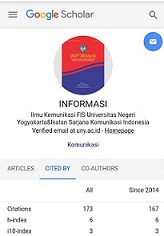The presumption of innocence: Interpretation and application in online journalism
DOI:
https://doi.org/10.21831/informasi.v52i2.54387Keywords:
Presumption of Innocence, Online Journalism, Trial by The Press, Journalistic EthicsAbstract
Implementation of the Presumption of Innocence by journalists has implications for the occurrence of trial by the press and potentially impacts social disharmony. This study aims to explain the interpretation of the presumption of innocence in journalism, and the understanding and application of the presumption of innocence by online media journalists. This research uses qualitative methods by utilizing two data collection techniques. Firstly, documentation that collects some related research about the Journalistic Codes of Ethics of the Press Council, PWI and AJI. Secondly, in-depth interviews with four online media journalists. The result shows that the literal interpretation of the presumption of innocence is a principle not to judge someone even though it is side by side with the principle of objectivity, covering both sides, mention of identity, and legal grammar. Online media journalists have a collective understanding of the presumption of innocence. However, the journalists have an authentic understanding that causes the different implementation of the presumption of innocence. Moreover, demands for faster news production, media agency policies, and personal interest from journalists also impact partial implementation. This research contributes by forming a model for applying the presumption of innocence for online media journalists to avoid trial by the press.
References
AJI. (2021). Kode Etik Aliansi Jurnalis Independen. In Aliansi Jurnalis Independen. Accesed from: https://aji.or.id/upload/Dokumen/Kode%20Etik%20AJI%202021.pdf.
Ashari, M. (2019). Jurnalisme Digital: Dari Pengumpulan Informasi Sampai Penyebaran Pesan. Inter Komunikasi: Jurnal Komunikasi, 4(1), 1–16.
Ayub, Z.A., & Yusoff, Z.M. (2018). Right of Online Informational Privacy of Children In Malaysia: A Statutory Perspective. UUM Journal of Legal Studies, 9(1), pp. 221-241.
Berti, C., & Loner, E. (2021). Character assassination as a right-wing populist communication tactic on social media: The case of Matteo Salvini in Italy. New Media and Society, 00(0), 1–22. https://doi.org/10.1177/14614448211039222
Bettoni, D. (2021). Vigilant Journalism: Ethical and Deontological Dilemmas. The 22nd Annual Association of Internet Researchers Conference, pp. 1–4. https://freedomhouse.org/report/freedom-net/freedom-net-2018
Bryman, A. (2012). Social research methods (4th Edition). London: Oxford University Press.
Christians, C. G. (2005). Ethical theory in communications research. Journalism Studies, 6(1), 3–14. https://doi.org/10.1080/1461670052000328168
Christians, C. G., Fackler, M., Richardson, K. B., Kreshel, P. J., & Wood Jr, R. H. (2017). Media Ethics: Cases and Moral Reasoning (Tenth Edition). London: Routledge. www.theccsn.com
Darbo, K. N., & Skjerdal, T. (2019). Blurred boundaries: Citizens journalists versus conventional journalists in Hong Kong. Global Media and China, 4(1), 111–124. https://doi.org/10.1177/2059436419834633
Denisova, A. (2022). Viral journalism. Strategy, tactics and limitations of the fast spread of content on social media: A case study of the United Kingdom quality publications. Journalism, 0(0), 1–19. https://doi.org/10.1177/14648849221077749
Dewan Pers. (2014). Kode Etik Jurnalistik. In Dewan Pers. Accessed from: https://dewanpers.or.id/assets/ebook/buku/822-
Dewan Pers. (2022). SIARAN PERS: Peter Gontha Sampaikan Langsung Pengaduan Terhadap Pikiran-Rakyat.com ke Dewan Pers. Accessed from: https://dewanpers.or.id/assets/documents/siaranpers/2022-05-27_Rilis_Media_Penyelesaian_Pengaduan_antara_Peter_Gontha_dengan_pikiran-rakyat.com.pdf
Dolunay, A., Elyeli, K., & Kasap, F. (2022). Unethical Practices and Effects of Digital Journalism in the COVID-19 Era: The Case of TRNC. SAGE Open, 12(2), 1–17. https://doi.org/10.1177/21582440221085266
Dorak, O. (2021). The Presumption of Innocence and The Protection of the Right to Privacy of Suspect and Accused. In The Presumption of Innocence and the Media Coverage of Criminal Cases. Center for the Study of Democracy. www.csd.bg
Eberholst, M. K., Hartley, J. M., & Olsen, M. B. (2016). Between ideals and practice: Journalism students facing ethical dilemmas in online newsroom teaching lessons from Denmark. Journalism and Mass Communication Educator, 71(2), 189–202. https://doi.org/10.1177/1077695815626302
Fadillah, D. (2015). KOMODIFIKASI SEKSUAL DALAM KEPENTINGAN EKONOMI PORTAL BERITA ONLINE. Informasi, 45(2), 155163–162. https://doi.org/https://doi.org/10.21831/informasi.v45i2.7990
Felle, T. (2016). Digital watchdogs? Data reporting and the news media's traditional "fourth estate" function. Journalism, 17(1), 85–96. https://doi.org/10.1177/1464884915593246
Graham, G. (2018). Teori-Teori Etika. Bandung: Nusa Media.
Griffin, E. M. (2012). A First look at communication theory (Fourth Edition). New York: McGraw Hill.
Habsari, H. T. (2017). Implikasi Hukum Asas Praduga Bersalah yang Digunakan Wartawan Dalam Pemberitaan Perkara Pidana. Arena Hukum, 10(2), 287–308. https://doi.org/10.21776/ub.arenahukum.2017.01002.7
Haltom, W., & McCann, M. (2004). Distorting the Law, Politics, Media, and the Litigation Crisis. Chicago: The University of Chicago Press.
Hansen, E. (2018). The fourth estate: The construction and place of silence in the public sphere. Philosophy and Social Criticism, 44(10), 1071–1089. https://doi.org/10.1177/0191453718797991
Hapsari, W. (2018). Konstruksi Media Daring Atas Putusan Sidang Kasus Pembunuhan I Wayan Mirna Salihin Dalam Tinjauan Kriminologi Konstitutif (Dekonstruksi Terhadap Pewacanaan Dominan Dalam Pemberitaan Kasus Kopi Sianida Pada detik.com). Jurnal Kriminologi Indonesia, 14(1), 43–56.
Haryadi, M. (2021, April 15). Dewan Pers Dapati 800 Aduan selama 2020, Dominan Pemberitaan dari Media Online Artikel ini telah tayang di Tribunnews.com dengan judul Dewan Pers Dapati 800 Aduan selama 2020, Dominan Pemberitaan dari Media Online. Detik.Com. https://www.tribunnews.com/nasional/2021/04/15/dewan-pers-dapati-800-aduan-selama-2020-dominan-pemberitaan-dari-media-online
Haryatmoko. (2007). Etika Komunikasi: Manipulasi Media, Kekerasan, dan Pornografi. Yogyakarta: Kanisius.
Huda, C. (2010). Makna Asas Praduga Tak Bersalah dan Pemakainnya dalam Praktek Pers. Jurnal Dewan Pers, 2, 33–44.
John, D. (2019). Media Trials: An Analysis of Ethical Issues. Journal of Emerging Technologies and Innovative Research, 6(2), 615–618. https://www.researchgate.net/publication/353945846
Joyce, V. de M. H., Saldaña, M., Weiss, A. S., & Alves, R. C. (2017). Ethical perspectives in Latin America's journalism community: A comparative analysis of acceptance of controversial practice for investigative reporting. International Communication Gazette, 79(5), 459–482. https://doi.org/10.1177/1748048516688131
Juditha, C. (2016). Obyektivitas Berita dan Etika Jurnalistik di Media Online: Kasus Rekrutmen Karyawan BUMN. Jurnal Pekommas, 1(1), 1–12.
Kovach, B., & Rosenstiel, T. (2021). The Elements of Journalism (Revised and Updated 4th Edition). New York: Taylor & Francis.
Larsen, A. G. (2021). Newsworthy actors, illegitimate voices: Journalistic strategies in dealing with anti-democratic and violent voices. Journalism, 22(1), 104–121. https://doi.org/10.1177/1464884918760865
Lestari, R. D. (2019). Shifting Journalistic Ethics in the Internet Age, Case Study: Violation of Journalistic Ethics in Journalistic Products and Journalist Behavior in Online Media. Jurnal Komunikator, 11(2), 142–150. https://doi.org/10.18196/jkm.1123027
Lestari, R. D. (2020). Jurnalisme Digital dan Etika Jurnalisme Media Sosial: Studi pada Akun Instagram @tempodotco dan @tribunjogja. Jurnal Ilmu Pengetahuan Dan Teknologi Komunikasi, 22(2), 159–174. https://doi.org/10.33164/iptekkom.22.2.2020.159-174
Loqman, L. (2010). Asas Praduga Tak Bersalah di dalam Pemberitaan oleh Media Massa . Jurnal Dewan Pers, 2, 1–18.
Lukman, Tsabit, M., Erlangga, C. Y., & Kusumawati, N. (2021). Trial By The Press New Media Konten Youtube Memasak Daging Babi Saus Kurma. Jurnal Media Penyiaran, 1(1), 46–52. https://tirto.id/tayangan-youtube-babi-kurma-dan-
Lynch, J. A. (2021). Deon and Telos: How Journalisms Are Evolving Their Ethical Approaches. Journalism and Media, 2(3), 484–498. https://doi.org/10.3390/journalmedia2030029
Maier, S. R. (2021). News coverage of human rights: Investigating determinants of media attention. Journalism, 22(7), 1612–1628. https://doi.org/10.1177/1464884919832722
Manan, B. (2016). Pers, Hukum, dan Hak Asasi Manusia. Jakarta: Dewan Pers. www.presscouncil.or.id
Martino, L. S. M., & Marques, A. C. S. (2014). Ethics and theories of communication: power, interactions, and a participative culture. Comunicaccao Sociedade, 25, 154–168.
Mateus, S. (2019). New Media, New Deontology: Ethical constraints of online journalism. Mediapolis – Revista de Comunicaí§í£o, Jornalismo e Espaí§o Público, 4(9), 13–26. https://doi.org/10.14195/2183-6019_9_1
Mayal, T. (2021). Presumption of Innocence and Dilution of Facts by Media Trials. International Journal of Legal Science and Innovation, 3(3), 475–482. https://doi.org/10.10000/IJLSI.11754
Miles, M. B., Huberman, A. M., & Saldana, J. (2014). Qualitative Data Analysis: A Methods Sourcebook. Third Edition. In The SAGE Handbook of Applied Social Research Methods (Third Edition). Sage Publications. https://doi.org/10.1177/239700221402800402
Mubarok, M., & Wulandari, D. (2018). KONSTRUKSI MEDIA DALAM PEMBERITAAN KONTRA TERORISME DI INDONESIA. INFORMASI, 48(1), 139–152. https://doi.org/10.21831/informasi.v48i1.18620
Mukantardjo, R. S. (2010). Asas Praduga Tak Bersalah Kesalahan Menurut Fakta dan Kesalahan Menurut Hukum. Jurnal Dewan Pers, 2, 45–52.
Mustawa. (2019a). Journalist Competence in Applying the Presumption of Innocence Principle on Press Release. Amir Law Journal, 1(1), 36–42.
Mustawa. (2019b). The model for regulating press coverage that applies the principle of presumption of innocence Mustafa. Indonesia Prime, 4(1), 58–67. https://indonesiaprime.or.id
Neuman, W. L., & Robson, K. (2018). Basics of Social Research: Qualitative and Quantitative Approaches. Pearson Canada Inc.
Nurhajati, L., Artini, & Wijayanto, X. A. (2018). Pemahaman dan Pelanggaran Kode Etik Jurnalistik Pada Jurnalis Indonesia.
Pérez, F. S., & Valera-Ordaz, L. (2021). Stolen innocence? Observance of the EU directive on a presumption of innocence by Spanish crime reporting. Communication and Society, 34(3), 15–30. https://doi.org/10.15581/003.34.3.15-30
Pura, M. H., & Kartika, R. Y. (2018). Efektivitas Penerapan Prinsip Asas Praduga Tidak Bersalah Atas Penggiringan Opini yang Dilakukan Perusahaan Pers Berdasarkan Pasal 5 Ayat (1) Undang-Undang Nomor 40 Tahun 1999 Tentang Pers. Jurnal Hukum POSITUM, 3(1), 71–89.
PWI. (2014). Kode Etik Jurnalistik Wartawan Indonesia. In Persatuan Wartawan Indonesia. https://prahumvii.files.wordpress.com/2014/11/kode-etik-jurnalistik-wartawan-indonesia-pwi.pdf.
Rae, M. (2020). Trial by media: Why victims and activists seek a parallel justice forum for war crimes. Crime, Media, Culture, 16(3), 359–374. https://doi.org/10.1177/1741659019874179
Reese, S. D., & Shoemaker, P. J. (2016). A Media Sociology for the Networked Public Sphere: The Hierarchy of Influences Model. Mass Communication and Society, 19(4), 389–410. https://doi.org/10.1080/15205436.2016.1174268
Åžahin, S. (2021). Journalism in conflict-affected societies: Professional roles and influences in Cyprus. Media, War and Conflict, 0(0), 1–17. https://doi.org/10.1177/1750635220987746
Samoilenko, S. A. (2021). The Applied Social Theory of Character Assassination Special, In Journal of Applied Social Theory, (Vol. 1, Issue 3).
Samoilenko, S. A., Erzikova, E., Davydov, S., & Laskin, A. (2017). Different Media, Same Messages: Character Assassination in the Television News during the 2014 Ukrainian Crisis. International Communication Research Journal, 52(2), 28–52. www.icrj-aejmc.com
Sari, N. (2020). Trial By The Press Terhadap Proses Peradilan Tindak Pidana Korupsi dalam Perspektif Asas Praduga Tidak Bersalah. RIO Law Journal, 1(2), 1–13.
Sobel, M., & McIntyre, K. (2018). Journalists' Perceptions of Human Rights Reporting in Rwanda. African Journalism Studies, 39(3), 85–104. https://doi.org/10.1080/23743670.2018.1495659
Stanić, K. M. (2020). How the theory of information and journalism ethics contributes to public relations ethics: six principles from the dialogue between codes of ethics and Luka Brajnović's legacy. Church, Communication and Culture, 5(1), 36–62. https://doi.org/10.1080/23753234.2020.1713013
Steele, J. (2013). "Trial by the Press": An Examination of Journalism, Ethics, and Islam in Indonesia and Malaysia. International Journal of Press/Politics, 18(3), 342–359. https://doi.org/10.1177/1940161213484588
Sujoko, A. (2021). Hukum Media: Regulasi Media dalam Perspektif Ilmu Komunikasi. Malang: Intrans Publishing.
Sujoko, A. (2022). The challenges of journalists in facing the new normal of the COVID-19 pandemic. Kasetsart Journal of Social Sciences, 43(2), 441–446. https://doi.org/10.34044/j.kjss.2022.43.2.23
Sujoko, A., & Larasati, G. P. (2018). Intervensi Media Sosial dalam Pergeseran Aktivitas Jurnalistik Online di Malang. Jurnal Komunikasi Islam, 7(2), 226–254. https://doi.org/10.15642/jki.2017.7.2.226-254
Sukardi, W. A. (2010). Menghindari Tuduhan Pelanggaran Asas Praduga Tidak Bersalah. Jurnal Dewan Pers, 2, 19–23.
Syahri, M. (2018). Ethics of Indonesian Journalists in the Era of Media Freedom. IOSR Journal Of Humanities And Social Science (IOSR-JHSS, 23(5), 34–38. https://doi.org/10.9790/0837-2305073438
Syahril, R., Rahmi, M., Sartika, R., & Rafiq, A. (2021). Trial By The Press Media Baru dalam Pemberitaan Video Syur Mirip Gisella Anastasia. Jurnal AKRAB JUARA, 6(1), 132–142. https://newsmaker.tribunnews.com/2020
Tanoos, A. (2017). Shielding The Presumption of Innocence from Petrial Media Coverage. Indiana Law Review, pp. 50, 997–1022.
Winora, R., Besman, A., & Hidayat, D. R. (2021). Penerapan Kode Etik Jurnalistik dalam Penulisan Berita Kriminal pada Media Online Infobekasi.co.id. Jurnal Kajian Jurnalisme, 4(2), 165. https://doi.org/10.24198/jkj.v4i2.29323
Downloads
Published
How to Cite
Issue
Section
Citation Check
License
Authors who publish with this journal agree to the following terms:
- Authors retain copyright and grant the journal right of first publication with the work simultaneously licensed under a Creative Commons Attribution License that allows others to share the work with an acknowledgement of the work's authorship and initial publication in this journal.
- Authors are able to enter into separate, additional contractual arrangements for the non-exclusive distribution of the journal's published version of the work (e.g., post it to an institutional repository or publish it in a book), with an acknowledgement of its initial publication in this journal.
- Authors are permitted and encouraged to post their work online (e.g., in institutional repositories or on their website) prior to and during the submission process, as it can lead to productive exchanges, as well as earlier and greater citation of published work (See The Effect of Open Access).











